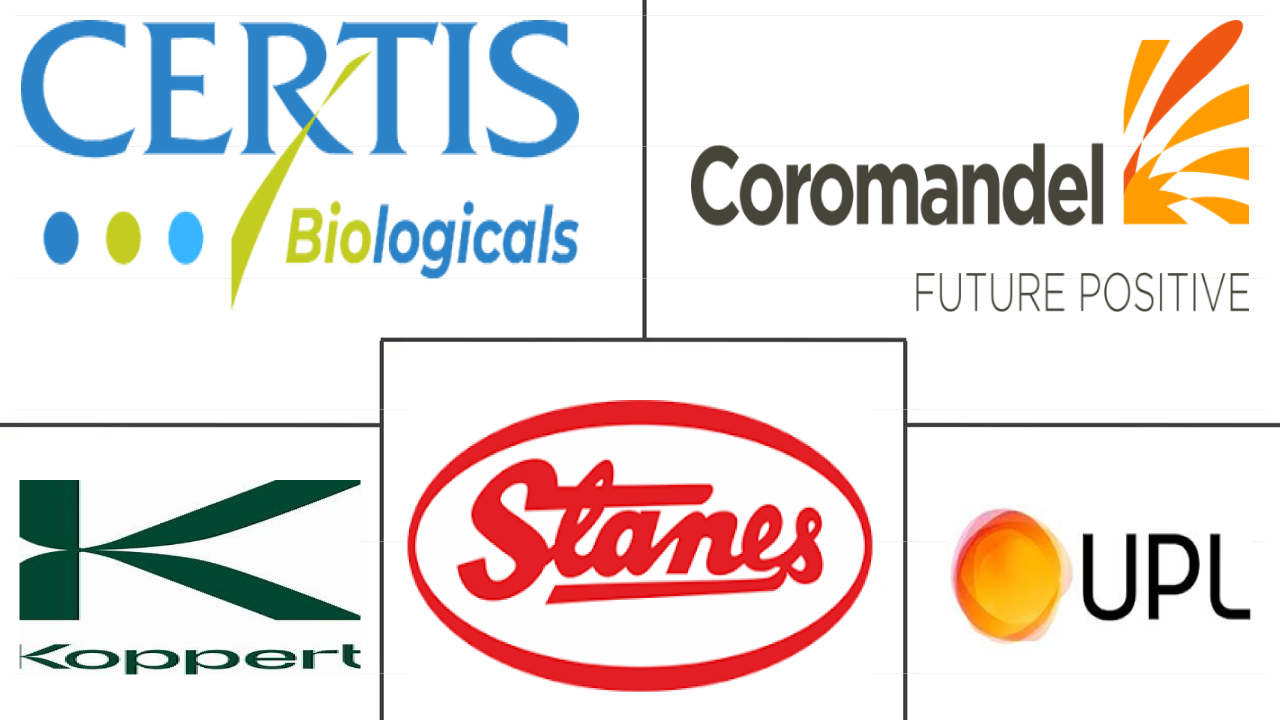Market Size of africa biopesticides Industry
|
|
Study Period | 2017 - 2029 |
|
|
Market Size (2024) | USD 160.85 Million |
|
|
Market Size (2029) | USD 269.16 Million |
|
|
Largest Share by Form | Biofungicides |
|
|
CAGR (2024 - 2029) | 10.84 % |
|
|
Largest Share by Country | Nigeria |
Major Players |
||

|
||
|
*Disclaimer: Major Players sorted in no particular order |
Africa Biopesticides Market Analysis
The Africa Biopesticides Market size is estimated at 160.85 million USD in 2024, and is expected to reach 269.16 million USD by 2029, growing at a CAGR of 10.84% during the forecast period (2024-2029).
160.85 Million
Market Size in 2024 (USD)
269.16 Million
Market Size in 2029 (USD)
5.26 %
CAGR (2017-2023)
10.84 %
CAGR (2024-2029)
Largest by Form
51.25 %
value share, Biofungicides, 2023
Biofungicides target particular plant diseases by using naturally present beneficial microbes and can kill both foliar diseases/infections and soil-borne root pathogens.
Fastest by Form
11.17 %
Projected CAGR, Biofungicides, 2024-2029
The application of biofungicides has grown significantly over time as a result of improved product accessibility and rapid technological improvements in the new products.
Largest by Crop Type
73.76 %
value share, Row Crops, 2023
Rice, Maize, Millet, Sorghum, Wheat, soybeans, yams, peanuts, beans, etc. are major row crops produced in the region. Biofungicides are most used biopesticides in row crops.
Largest by Country
15.82 %
value share, Nigeria, 2023
In 2022, biofungicides are most used biopesticides in the country with 47.2% market share, row crops are dominating the biopesticide consumption in the country with 58.9%.
Leading Market Player
4.42 %
market share, UPL, 2022

The company offers wide range of biological plant protection products like biofungicides and bioinsecticides to customers, which target a wide range of crop pests.
- Biopesticides are naturally occurring substances or agents derived from animals, plants, insects, and microorganisms, including bacteria and fungi, used to manage agricultural pests and infections. The African biopesticides market grew by 23.4% from 2017 to 2022.
- Biopesticide consumption in row crops is higher than other crops in the region, accounting for 73.8% in 2022. Horticultural crops accounted for 19.7%, while cash crops accounted for 6.5% of the overall consumption in the same year.
- The Integrated Pest Management (IPM) concept is important in the African biopesticides market. IPM 1.0 was established decades ago to reduce the overuse of agricultural pesticides. IPM 2.0 gradually incorporated agroecological principles such as biological control and habitat management. However, throughout this period, smallholder farmers did not improve their decision-making skills and continued to rely on hazardous pesticides as their first line of defense. The African region also implemented Integrated Pest Management 3.0 (IPM 3.0), which includes three new features, i.e., real-time farmer decision-making access, pest-management options based on science and nature, and the integration of genomic approaches, biopesticides, and habitat-management practices. These IPM practices may drive the biopesticides market in Africa.
- In collaboration with Real IPM Ltd, the International Centre of Insect Physiology and Ecology commercialized two biopesticides, Campaign (icipe69) and Achieve (icipe78). Campaign (icipe69) is being used against mealybugs, thrips, and fruit flies, in crops such as cucumber, mango, papaya, rose, and tomato. Adoption of IPM practices and increased R&D activities of biopesticides may boost the market value by 84.7% during 2023-2029.
- The African biopesticides market has exhibited a growth rate of 15.8% between 2017 and 2021, and this growth is expected to continue with a projected expansion of about 84.7% by 2029.
- This growth is primarily attributed to the launch of Integrated Pest Management 3.0 (IPM 3.0) in Africa. This pest management strategy is based on three pillars: real-time farmer decision-making access, science-based pest-management alternatives, and the combination of genetic methods, biopesticides, and habitat-management strategies. These IPM methods are expected to play a critical role in driving the growth of the African biopesticides market.
- Biofungicides are the dominant segment of the biopesticides market in the Rest of Africa segment, and it was valued at USD 45.6 million in 2022. Trichoderma is widely used as a biofungicide as it destroys other fungi enzymatically and produces anti-microbial substances that kill pathogenic fungi.
- Egypt, South Africa, and the Rest of Africa are the primary segments in the African region regarding organic agriculture acreage. In 2022, the Rest of Africa accounted for 95.0% of total organic agricultural land in Africa, with 1.2 million hectares. Egypt contributed 3.5% with 45.1 thousand hectares, while South Africa accounted for 1.0% with 12.6 thousand hectares. The high organic agricultural acreage in these countries provides significant market opportunities.
- The increasing consumer interest in organic products, growing awareness among farmers, and the economic advantages of using biopesticides are anticipated to drive the demand for biopesticides in Africa, and the market is expected to record a CAGR of 9.2% during the forecast period.
Africa Biopesticides Industry Segmentation
Biofungicides, Bioherbicides, Bioinsecticides are covered as segments by Form. Cash Crops, Horticultural Crops, Row Crops are covered as segments by Crop Type. Egypt, Nigeria, South Africa are covered as segments by Country.
- Biopesticides are naturally occurring substances or agents derived from animals, plants, insects, and microorganisms, including bacteria and fungi, used to manage agricultural pests and infections. The African biopesticides market grew by 23.4% from 2017 to 2022.
- Biopesticide consumption in row crops is higher than other crops in the region, accounting for 73.8% in 2022. Horticultural crops accounted for 19.7%, while cash crops accounted for 6.5% of the overall consumption in the same year.
- The Integrated Pest Management (IPM) concept is important in the African biopesticides market. IPM 1.0 was established decades ago to reduce the overuse of agricultural pesticides. IPM 2.0 gradually incorporated agroecological principles such as biological control and habitat management. However, throughout this period, smallholder farmers did not improve their decision-making skills and continued to rely on hazardous pesticides as their first line of defense. The African region also implemented Integrated Pest Management 3.0 (IPM 3.0), which includes three new features, i.e., real-time farmer decision-making access, pest-management options based on science and nature, and the integration of genomic approaches, biopesticides, and habitat-management practices. These IPM practices may drive the biopesticides market in Africa.
- In collaboration with Real IPM Ltd, the International Centre of Insect Physiology and Ecology commercialized two biopesticides, Campaign (icipe69) and Achieve (icipe78). Campaign (icipe69) is being used against mealybugs, thrips, and fruit flies, in crops such as cucumber, mango, papaya, rose, and tomato. Adoption of IPM practices and increased R&D activities of biopesticides may boost the market value by 84.7% during 2023-2029.
| Form | |
| Biofungicides | |
| Bioherbicides | |
| Bioinsecticides | |
| Other Biopesticides |
| Crop Type | |
| Cash Crops | |
| Horticultural Crops | |
| Row Crops |
| Country | |
| Egypt | |
| Nigeria | |
| South Africa | |
| Rest of Africa |
Africa Biopesticides Market Size Summary
The African biopesticides market is poised for significant growth, driven by the increasing adoption of Integrated Pest Management (IPM) strategies and the rising demand for organic agricultural practices. Biopesticides, derived from natural sources such as plants, animals, and microorganisms, are gaining traction as sustainable alternatives to chemical pesticides. The market's expansion is supported by the implementation of IPM 3.0, which integrates real-time decision-making, science-based pest management, and genomic approaches. This innovative approach is expected to enhance the efficacy of biopesticides and boost their adoption across various crop types, including row, horticultural, and cash crops. The collaboration between organizations like the International Centre of Insect Physiology and Ecology and Real IPM Ltd has further facilitated the commercialization of biopesticides, contributing to the market's growth.
The demand for biopesticides in Africa is also fueled by the increasing consumer interest in organic products and the economic benefits associated with their use. Countries such as Egypt, South Africa, and the Rest of Africa are leading in organic agricultural acreage, providing substantial opportunities for biopesticide market expansion. Despite challenges like low-income levels and the lack of organic standards, the market is expected to grow steadily, supported by the rising per capita consumption of organic foods and beverages. The fragmented nature of the market, with key players like Certis USA LLC, Coromandel International Ltd, and Koppert Biological Systems Inc., indicates a competitive landscape that is likely to drive innovation and development in biopesticide technologies.
Africa Biopesticides Market Size - Table of Contents
-
1. MARKET SEGMENTATION (includes market size in Value in USD and Volume, Forecasts up to 2029 and analysis of growth prospects)
-
1.1 Form
-
1.1.1 Biofungicides
-
1.1.2 Bioherbicides
-
1.1.3 Bioinsecticides
-
1.1.4 Other Biopesticides
-
-
1.2 Crop Type
-
1.2.1 Cash Crops
-
1.2.2 Horticultural Crops
-
1.2.3 Row Crops
-
-
1.3 Country
-
1.3.1 Egypt
-
1.3.2 Nigeria
-
1.3.3 South Africa
-
1.3.4 Rest of Africa
-
-
Africa Biopesticides Market Size FAQs
How big is the Africa Biopesticides Market?
The Africa Biopesticides Market size is expected to reach USD 160.85 million in 2024 and grow at a CAGR of 10.84% to reach USD 269.16 million by 2029.
What is the current Africa Biopesticides Market size?
In 2024, the Africa Biopesticides Market size is expected to reach USD 160.85 million.

